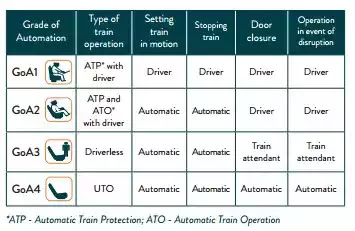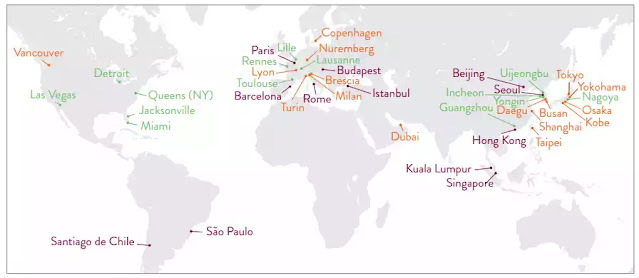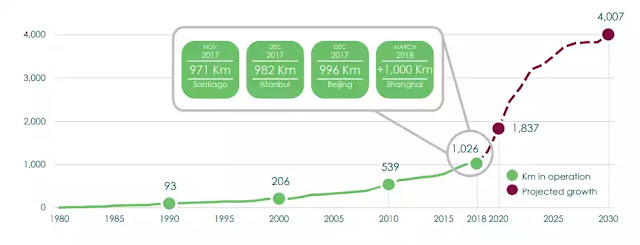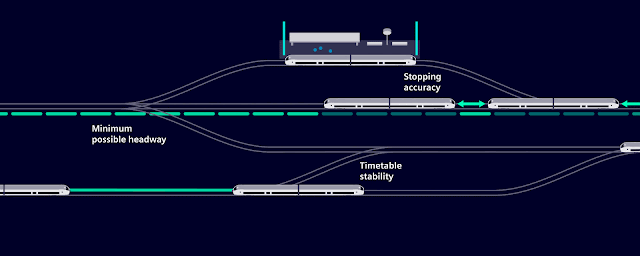When it comes to Automatic Train Operation (ATO), the word 'Driverless' is often used and leads to the understanding that there is no attendant or driver in the train but this is not always true for many GoA (Grade Of Automation, explanation in the next chapter) that require the presence of a driver or an on-board staff.
ATO is a system that helps to automate trains, frequently used in metros as it's easier to ensure security and less used in mainlines that need more development to reach a higher level of automation and can be widely used as much as metros.
In the 60s were the first use of ATO in the United States of America (New York) and United Kingdom (London).
Grade of Automation (GoA)
GoA, as its name suggests, is the degree of the automation of a train depending on how much humans are evolved. The GoA is classified up to 4 levels as specified in The International Electrotechnical Commission (IEC) standard IEC 62290-1 and defined by the UITP (International Association of Public Transport):
 |
| Grade Of Automation Levels Credit: UITP |
GoA0: Manual operations with no Automatic Train Protection (ATP).
GoA1: Manual Operation with Automatic Train Protection.
GoA2: Semi-automatic train operation (STO); Train has ATO in addition to the ATP and it drives and brakes automatically with the presence of a driver in the cab that ensures some functions as closing the doors.
GoA3: Driverless train operation (DTO); Train equipped with ATO and ATP but with the presence of on-board staff.
GoA4: Unattended train operation (UTO); train operates fully automatically with no driver or attendant on it. For this GoA, control cabs are not required anymore in the rolling stock.
ATO & Metros
Automatic Metros - Statistics
According to a report about metro automation published in 2018 by UITP (International Association of Public Transport), in March 2018, automated metros reached the 1,000km milestone with the opening of the Pujiang Line in Shanghai. As of December 2018, nearly a quarter of the world’s metro systems have at least one fully automated line in operation.[]
by putting in service the Pujian Line in Shanghai, automated metros are operating 1 026 km around the world in 64 lines in 42 cities which represents an increase of more than a quarter -- or 27.7% -- compared to the 2016 World Report. The number of automated metro km worldwide is expected to triple by 2023, in particular in China, if the confirmed projects maintain their plans.
 |
| Cities with fully automated metro lines in operation, as of 31 December 2018 Source: UITP |
Beyond 2023, forecasts based on confirmed projects show the number of automated metro km will preserve and will reach more than 3 800 km by 2028 whether by creating new lines or extending existing ones.
 |
| Forecasts of the evolution of the number of automatic metro km Source: UITP |
UITP makes it also possible to see an online map of the automated metros in the world through a website that created it.
CBTC for metro automation:
Most of the metros in the world are using CBTC (Communications-Based Train Control) system to achieve a GoA 4. How is this system works is shown in the video below:
ATO & Mainline
ATO for mainline isn't as developed as for metros with few examples around the world, in particular, in Europe that conducted and is conducting some projects to develop it more such as:
X2Rail-1 Start-up activities for Advanced Signalling and Automation Systems coordinated by Siemens Mobility
X2Rail-4: Advanced signalling and automation system - Completion of activities for enhanced automation systems, train integrity, traffic management evolution, and smart object controllers coordinated by Alstom.
The video above shows one of the joint development projects within the Shift2Rail development program to develop ATO over ETCS specifications:
Read also ERTMS, what you need to know.
ATO over ETCS architecture and specifications
For mainline, AoE (ATO over ETCS) is used following this architecture and specifications and is capable at this stage to reach GoA2.
 |
| ATO over ETCS Architecture Credit: UNIFE |
 |
| ATO over ETCS Credit: Siemens Mobility |
0 Comments
Post a Comment